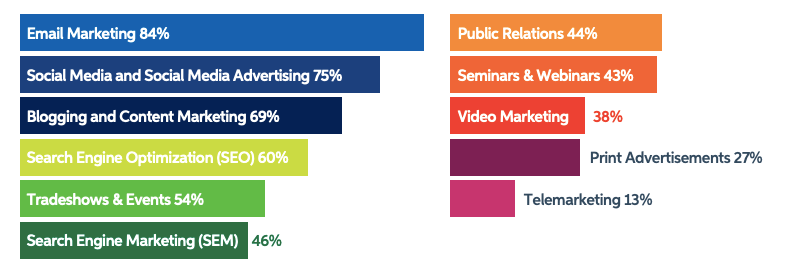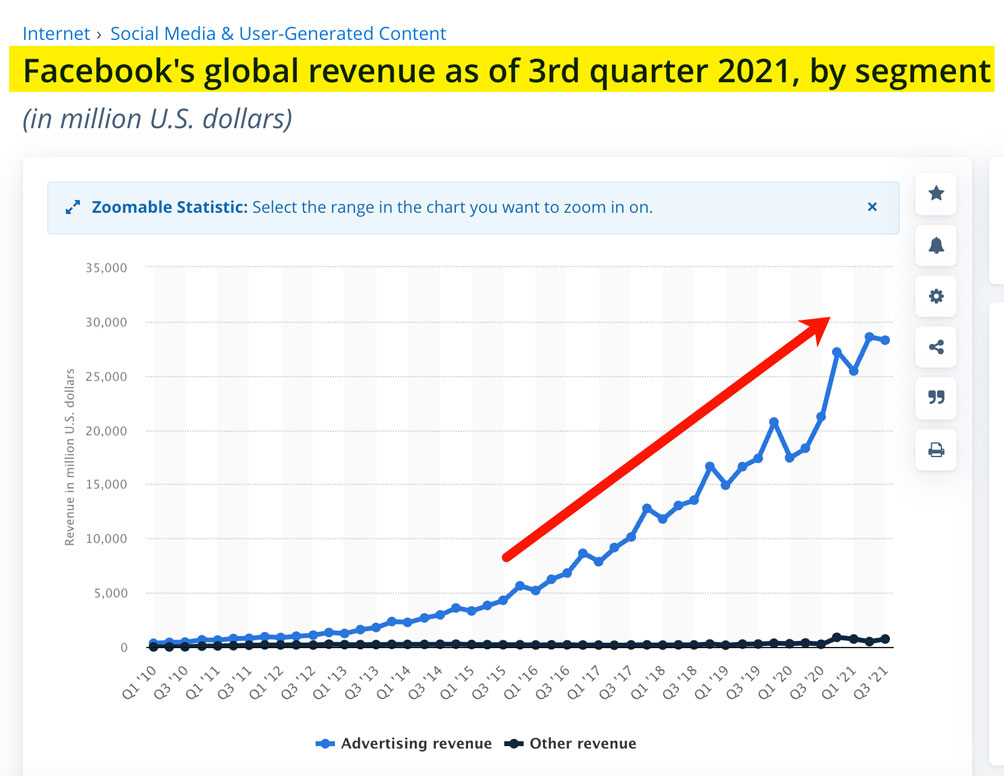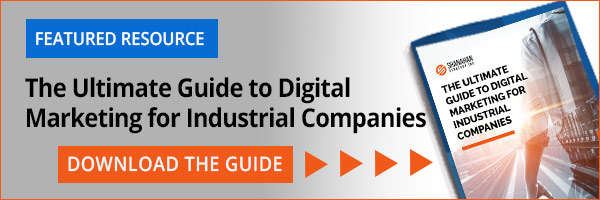While digital marketing isn’t a new concept, many manufacturing companies still rely on traditional methods to promote their brand and products. Sure, tradeshows, word-of-mouth referrals, and networking still work, but as industrial consumers evolve their buying patterns, implementing the top digital marketing tips for manufacturers is essential for long-term growth.
In this post, you’ll discover the ways manufacturing companies build a solid digital presence to attract new buyers and increase conversion rates with loyal customers. With 46% of total marketing spend allocated towards digital tactics, it’s more important than ever for manufacturers to leverage digital tactics to remain competitive in industrial industries.
Ready to learn how to leverage digital marketing for your brand? Let’s dive in.
Key Takeaways:
- To avoid random acts of marketing, an overall strategy should always come before tactics
- Creating a concise definition and profile of your ideal buyers are critical to your long-term success
- Manufacturers can implement a customer-centric marketing strategy with inbound digital tactics
- Digital marketing helps businesses improve brand reputation and attract high-quality leads
- Channels like websites, PPC ads, and content development help promote your digital presence to new buyers and follow their customer journey to attract and close new business
Inbound vs. Outbound Digital Marketing for Manufacturers
You can break marketing into two different types: outbound and inbound. Outbound tactics focus on casting a wide net to a larger audience through one-way communication methods like traditional broadcast media, print ads, direct mail, events, and billboards. The main goal is to reach as many people as possible, regardless of their demographics or buying patterns. For these methods to be effective, you need to personalize your outreach and adopt a frequent cadence.
However, inbound marketing implements a customer-centric approach that builds a relationship with the audience through relevant content and touchpoints. Focusing on digital channels, inbound marketing includes the following methods:
- Content marketing
- Websites
- Video
- Search Engine Optimization (SEO)
- Email marketing
- Pay-per-click (PPC) ads
- Social media marketing

Why Should Manufacturers Invest in Digital Marketing?
If you’re still relying on outbound marketing to reach industrial buyers, remember that the customer journey has changed. The power now resides with your buyers, not your brand. With 68% of purchases starting with a search engine, buyers can find the information they need with a click of a button. If you’re not providing relevant answers, you’ll quickly lose customers to competitors who are.
Overall, digital marketing helps solve pain points for your brand and customers. Here are a few benefits of adopting a digital strategy:
- Helps prospective customers solve common problems with proven solutions
- Educates buyers on your products and services
- Improves brand reputation within your industry
- Generates quality leads who are looking for similar companies
- Increases your sales pipeline
- Humanizes your brand and brings it to life through storytelling
10 Digital Marketing Tips for Manufacturers Getting Started
Adopting a manufacturing digital marketing strategy will help you attract high-quality industrial buyers and increase your bottom line. Let’s look at some of the top digital marketing tips for manufacturers in 2022:
1. Strategy Should Always Come Before Tactics
No matter what your situation, it’s rarely recommended to start with marketing tactics before developing and documenting a clear strategy or marketing roadmap. Your strategy is the overarching action plan that takes you where you want to go, while tactics are the individual steps and actions that will get you there. In a business context, this means the specific actions teams take to implement the initiatives outlined in the strategy.
We frequently see manufacturing companies operating without any sort of strategy and simply implementing an ad hoc assortment of marketing tactics. This “spray and pray” or “random acts of marketing” approach rarely produces any positive results while wasting time and valuable resources.
- Marketing Audit – This takes a deep dive and evaluates your current situation and competition to determine where you should invest to make the best short and long-term gains. When done by a team backed by years of experience working with leading brands in a broad range of different industries, your odds of getting a comprehensive strategy paired with a detailed roadmap of tactics are greatly improved.
- Marketing Roadmap – Start with analyzing your business and building a detailed Marketing Roadmap to help you get and stay on track to achieve your marketing goals and drive sales growth. This isn’t just theory, but a detailed look at you and your key competitors. When done by an experienced team, they can help assess how you stack up and then build a detailed strategy (Roadmap) to help you close the gaps and gain market share.
Once you have a thorough assessment paired with a strategy you can determine how to best execute the strategy based on your budget and expertise. In many cases, companies without the in-house expertise find it’s more effective (i.e., cost, speed, focus, expertise, etc.) to leverage an external marketing agency with the execution.
2. Create Accurate Buyer Personas
Before jumping into channel tactics, you need to understand your customers and their needs. To get started, consider developing buyer personas to represent your ideal customers based on internal research and data. Buyer personas help your organization target qualified prospects, develop campaigns that meet your customer’s needs and guide product development.
You need to develop buyer personas through research, interviews, and surveys with contacts in your database that closely align with your target audience. From there, you’ll identify commonalities between the different accounts to develop at least one primary persona. Your next steps include:
- Write the persona’s basic demographic data like job title, location, interests, and mannerisms.
- Share the information you learned during the research stage like the contact’s motivations, goals, and challenges.
- Create sales enablement training and materials to prepare them for future interactions.
- Develop key messaging for your entire organization to use in any communications with prospects.
Once you develop buyer personas, you’ll be able to create more targeted campaigns that better suit your ideal customer’s needs and present your company as the solution.
3. Develop and Optimize Your Website
Your website acts as your first digital impression and gateway to your brand. With 50% of consumers believing that a website is essential to a brand’s overall success, your website has the potential to provide valuable information, capture leads, and drive purchase decisions. However, just having a website isn’t enough anymore — it needs to be aesthetically pleasing, include easy functionality, and contain valuable content.
Here are a few essential items to include in your manufacturing website:
- Lead forms that capture prospect’s contact information for your marketing and sales teams
- Call-to-actions (CTAs) that drive users to take action throughout the website
- Strong messaging and relevant product pages to provide users with information
- Appealing images and videos that tell your brand story and help you stand out
- Provide relevant resources that address common challenges faced for your target customers
- An easy user experience that allows users to find the information they need quickly
Lastly, it’s essential to include on-page search engine optimized (SEO) content and on-page technical elements like metadata. By adhering to SEO best practices, you can rank higher in search engine result pages and build your overall domain authority — resulting in more website visits and conversions the higher you rank.
4. Include SEO in Your Web Strategy
SEO stands for search engine optimization, which is a set of practices designed to improve the appearance and positioning of your web pages in organic search results. Because organic search is the most prominent way for people to discover and access your online content, a good SEO strategy is essential for improving the quality and quantity of traffic to your website.
Depending on your industry and competitors, an effective SEO strategy will most often including the following key elements.
- Keyword Research -Keyword research is the process of finding and analyzing search terms that people enter into search engines with the goal of using that data for a specific purpose, often for search engine optimization (SEO) or general marketing. Keyword research can uncover queries to target, the popularity of these queries, their ranking difficulty, and more.
- On-Page SEO – On-page SEO (also known as “on-site SEO”) is the practice of optimizing web page content for search engines and users. Common on-page SEO practices include optimizing title tags, content, internal links, images and URLs.
- Technical SEO -Technical SEO refers to website and server optimizations that help search engine spiders crawl and index your site more effectively (to help improve organic rankings).
- Local SEO – If you want to be more visible to local consumers online, you’ll need to get to grips with local search engine optimization (SEO). With 46% of all Google searches performed by people looking for products, services, or information in their local area, improving your local search presence could clearly benefit your business.
- Links and Link Building -Links are immensely important for SEO and make up the lion’s share of “off-site SEO” (also called “off-page SEO”). Characteristics of a site’s internal and external links can greatly influence its rankings within search engine results pages (SERPs).
When done correctly, a good SEO strategy will pay huge dividends in the long run while avoiding excessive spending on paid search advertising (e.g. PPC or pay-per-click advertising).
5. Invest in Digital Advertising
Once you develop a website, you can leverage digital marketing advertising options to target your customers based on their demographics, geographic location, interests, and buying behaviors. With the correct targeting in place, advertising allows you to follow the prospect along their buying journey to provide the right messaging at the right time.
While the digital marketing industry is vast, you’ll want to test out a few channels, so you understand what your audience prefers to digest and where they spend the most time. Get started with:
- Email Marketing: Still a massive channel for manufacturers, you can follow prospects through the customer journey with email campaigns that target their activity. You can also leverage transactional and onboarding emails depending on your audience.
- Pay-Per-Click (PPC) Ads: Through popular search engines like Google and YouTube, you can develop PPC ads that target users who are already looking for similar services. These can also include display ads or campaigns with industry magazines and associations to target a niche audience.
- Social Media: With both organic and paid campaigns available, you can promote your brand to a segmented audience and share valuable brand updates. Many manufacturers find success on platforms like LinkedIn, Facebook, Twitter and Instagram.

6. Create Valuable Video Content and Thought Leadership
One of the most important ways to leverage digital marketing is by developing content that attracts buyers and keeps them engaged on your other channels. With 122 million people watching YouTube each day producing video content is a great way to show off your facility, behind-the-scenes, or complex how-to videos that are difficult to explain on paper.
Here are a few best practices for creating actionable video content:
- Hook your audience within the first ten seconds of the video and set expectations
- Tell a clear story arc, with a beginning and an end, which allows you to connect with your viewers
- Provide educational content that helps viewers learn more about your products or services without coming off too salesy
- Ensure that your videos still work without sound, which is especially important if you plan to share the video content on social media
- Use customer behavior and data to create content that your audience wants and cares about
If you’re looking to stand out from competitors, creating thought leadership differentiates your brand and brings you to the forefront of the industry. For example, consider writing long-form articles or interviews for industry publications, LinkedIn, Forbes, or Medium to expand your reach and readership. Over time, this content will build a positive brand reputation and help you improve search engine rankings, backlinks, and website traffic.
7. Reporting and Analytics
Setting goals and measuring results are critical to any effective digital marketing strategy. Not only will analytics help you determine what’s working, it will also help you determine what’s not working. Without a reliable way to monitor, measure, report and analyze results, you’re essentially working in the dark!
At its core, marketing analytics is about identifying patterns within data that help you make smarter marketing decisions. You can analyze a single platform or campaign, or look at how multiple campaigns interact with each other and with your customers to drive revenue.
Insights from this kind of analysis will give you a deeper understanding of where your customers are and where the market as a whole is going. You can stop being reactive and start being proactive — and ensure that your marketing activities achieve maximum efficiency and impact for your business.
8. Focus on Conversion Rate Optimization (CRO)
Conversion rate optimization (CRO) is the process of improving digital experiences and encouraging users or prospective buyers to take action. Common CRO tactics include A/B testing and user behavior analyses across web pages, emails, and digital advertising campaigns.
The goal of CRO is to increase the number of people taking acting. While CRO is somewhat analytical and looks at these numbers factually, it’s equally important to understand the psychology behind human behavior and decision-making.
You don’t need stats to know we live in a digital age. Optimizing your digital assets to improve your sales is a no-brainer, and that’s exactly what CRO is. Trying to get more people to call your company? Optimizing for that phone number placement on your website is part of CRO.
Another reason to care about CRO is if you’re spending time and money on advertising. Why would you spend resources to bring users into your store or your website, but then leave them completely to their own devices? Focusing more on turning those visitors into conversions will bring you greater ROI for your marketing campaigns.
9. Leverage the Power of a CRM
A customer relationship management (CRM) system collects, organizes, and manages all of your customer-related information so you can track the buyer’s journey for every individual you interact with, streamline communication, enhance the customer experience, and improve data management.
A few reasons why a CRM can help you grow better include:
- Center your business growth around customers
- Align your sales, marketing and service teams
- Sync and share data with ease
- Automate routine tasks to ensure consistency
- Create workflows to initiate and complete processes
- Simplify customer interactions
- Build dashboards to measure and monitor what matters for your business
CRMs are powerful tools that can help you expedite business growth while eliminating friction, collaborate cross-team, manage your contact records, sync data, automate daily tasks, and more.
10. Take Advantage of Automation and Technology
It’s easy for marketers to get caught up in the day-to-day tactics and activities that it takes to maintain a successful digital strategy. Instead, manufacturers can leverage marketing technology and automation to become more efficient, execute campaigns, and measure performance results to optimize future efforts.
Bottom line: technology helps you automate processes to make your job easier and allows you to focus on the bigger picture. Here are a few examples of technology you should consider investing in:
- Website and Social Media Analytics: Track website behavior, engagement, and SEO growth over time.
- Content Management System (CMS): Edit, schedule, and manage all website content.
- Customer Relationship Manager (CRM): Manage and track interactions with all prospects and customers.
- Marketing Automation: Deliver communications at the right time, to the right people, across multiple marketing channels like email marketing and social media.
- Live Chat/Chatbots: With live chat, you give customers a way to reach you at the exact moment that they have questions or problems they can’t solve.
- Data Visualization: Tools like Google Data Studio features widgets, graphs, charts, and maps to quickly and automatically visualize and share your data across your organization for better and more accurate decision-making.
You can also leverage technology to build positive relationships with your customers with conversational marketing. For example, utilizing a chatbot on your website is an effective way to answer questions 24/7 and give you a direct contact line to customers. By providing instant answers, you can collect valuable information to guide content development like FAQ documents, sales collateral, training, and more.
Your Business Growth Starts with a Digital Marketing Strategy
While getting started with digital marketing may seem complicated, it’s an excellent way for manufacturers to gain exposure to new audiences and increase conversions by providing deeper customer relationships. You’ll want to create buyer personas to understand your buyers’ needs, challenges, and preferred digital channels to get started. From there, you’ll develop tailored pillar messaging based on your customers to create better engagement and campaigns that attract high-quality leads.
Ready to grow your digital marketing strategy? Get started with Shanahan Strategy Inc.

